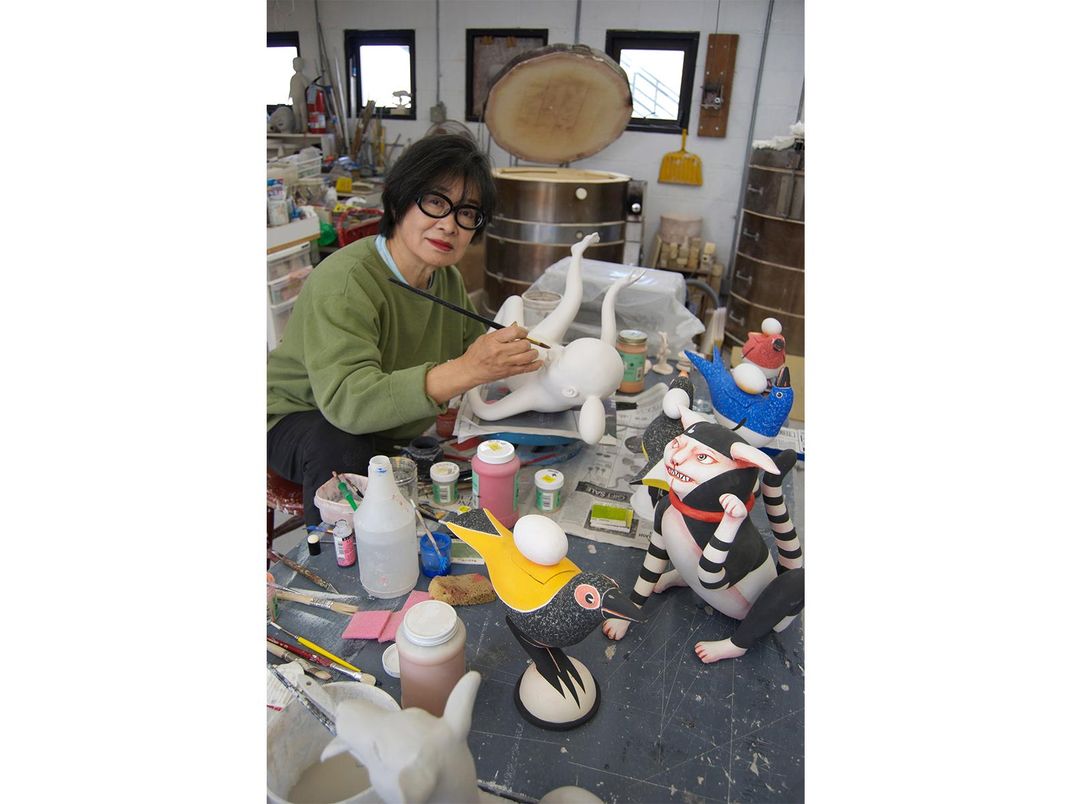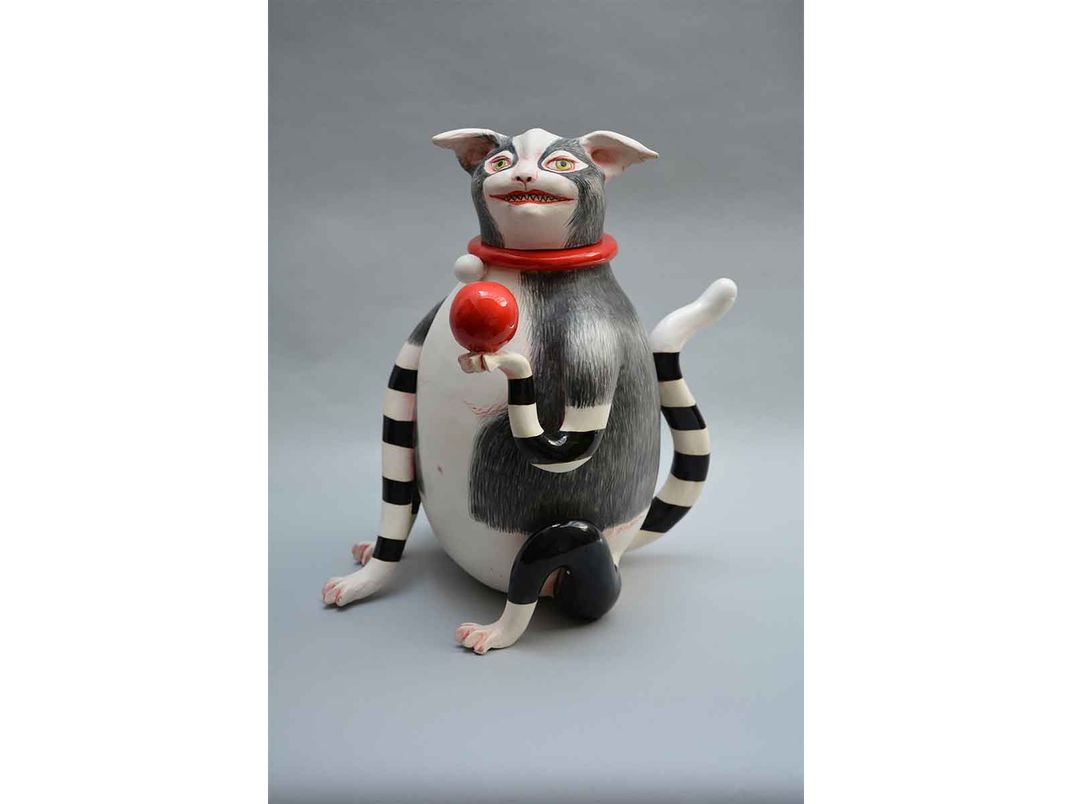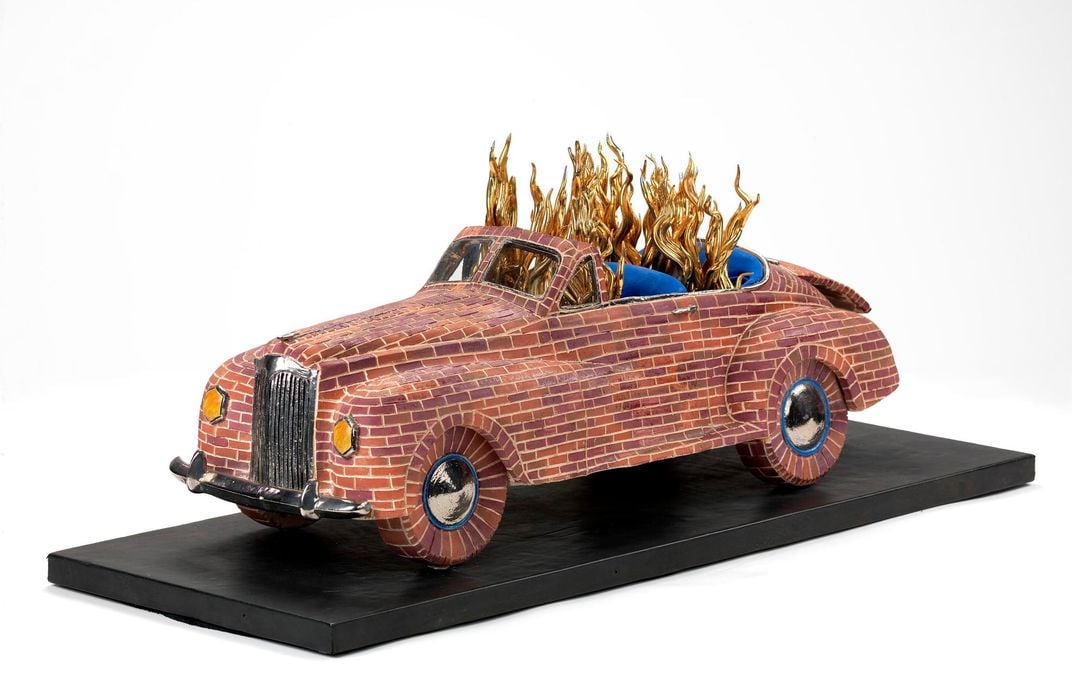For This Year’s Crop of Smithsonian Craft Show Artists, the Pandemic Changes Everything
Ceramicist Patti Warashina, the winner of the show’s prestigious Visionary Award, reflects on how her artwork reveals the surreal of these times
/https://tf-cmsv2-smithsonianmag-media.s3.amazonaws.com/filer/c6/3f/c63fb73e-f1fc-4cc4-8275-e66be2c2ec94/ladyliberty.jpg)
It was a year ago when jurors decided on the 100 top artists and crafts people to be included in the 2020 edition of the 38th edition of the prestigious Smithsonian Craft Show—back in the days when people could meet freely.
But the lavish springtime showcase at the National Building Museum in Washington, D.C. was delayed from April to the fall. And eventually the Craft Show became, like nearly everything else in the arts this year, a strictly online event. For 13 days from October 13 to 25, the works of the selected contemporary crafters will be on display and for sale through the Bidsquare.com platform. (The proceeds provide critical funding to the Institution's research, educational programs and exhibitions.)
Festivities kick off Tuesday with a special Smithsonian Visionary Award ceremony given to celebrated Seattle ceramicist Patti Warashina. The craft show gala, which will also be virtual, will be held October 21 with host celebrity chef Carla Hall and speaker Smithsonian Secretary Lonnie G. Bunch III, followed by an online live auction.

The pandemic even seems to have dominated the homepage for the 2020 event, with a big photograph of Judith Kinghorn’s gold pendant that looks for all the world like COVID-19 virus (instead, it’s a similarly round allium flower from the Minneapolis jewelry designer who often turns to nature for inspiration).
“Nature, as always, is a great inspiration for all these designers, especially when you’re working with your hands and using natural materials, says Emily Orr, an assistant curator at the Cooper Hewitt Smithsonian Design Museum, who served as one of the show’s three jurors, along with glass artist Toots Zynsky and Kari Herrin from the Savannah College of Art and Design.
“This year there was a real aim to extend the boundaries of what’s included,” says Orr. That meant an increased focus on design to reflect contemporary ways of craft making, including things that were 3-D printed and incorporated other new technology in their making. “That’s not something that’s been considered in previous years, so that was a big shift.”

Categories for the show remained the same—ceramics, fiber and basketry, furniture, glass, jewelry, leather and metal, paper, wearable art and wood. But entries within those categories grew. “There’s just such diversity within those categories, you really see the range of work that’s being made in mostly traditional materials and how the boundaries are being pushed,” Orr says. “In the category of wood, for instance, there were guitars, brooms and handbags. This is not a typical group that you might classify together had they not been grouped together by their material.”
The broom-maker, Hannah Beatrice Quinn, represents two other aspects of a more diverse Craft Show this year—a younger artist, at 27, and one whose wares are modestly priced.
“I don’t want to make things I can’t afford,” says Quinn, a Washington, D.C. native who recently set up shop in Santa Fe. Like a lot of artists, she says the pandemic has allowed her more time in the studio though she had trouble at first setting up an online business. “Going virtual is hard for me,” she says. “I’m not a computer person.”

While it’s the first time in the Craft Show for Quinn, another young artist, Sara Thompson of Portland, Oregon, is back for her third time at only 24. “A lot of the people I met at shows have been doing this longer than I’ve been alive,” says Thompson, who works in sterling silver vessels. But she’s old enough to understand the economics of the moment. “This pandemic points out how fragile artists’ incomes are,” she says. “Virtual shows won’t come close to replacing the income I’ve lost to the pandemic.”
It’s the same for longtime fixtures of the Craft Show for years, such as Cliff Lee, 69, of Hershey, Pennsylvania, whose ceramics have been part of the show for 30 years. “There are no shows and no collectors able to travel, so my income has disappeared,” Lee says of the shutdown. “I have taken refuge in my studio.”
It’s tough, too, for Holly Anne Mitchell of Indianapolis who makes jewelry out of newspaper comics. “The isolation, the quarantine,” she says. “I miss being around people.”

But for Warashina, winner of the Visionary Award, the isolation is normal. “I’m used to being in my studio by myself,” she says over the phone from Seattle. At 80, she’s working on a series of drawings that respond to the urgency of the time. “It’s crazy—the hurricanes, the fires, the politics,” she says. “I guess it’s just so surreal, and I love surrealism.”
The drawings may be a departure from her ceramic work, which has also drawn on surrealism but is marked by its humor as well. “That’s a welcome thing to see, especially now,” says Orr of Warashina’s irreverent and sometimes unexpected humor. “I’m really pleased that they chose to honor someone like that.”
“The ability for objects to do storytelling—I think that’s where she really excels,” Orr says.
Born in Spokane, Washington, in 1940, Warashina went to the University of Washington intending to study science and medicine, but a drawing class in her freshman year changed all that. “I just loved it,” Warashina says. “I was really pulled to it.” She took a variety of foundation art classes after that until she began working with clay.
“It was the material that hooked me,” Warashina says. “Something about the touch of it. It was the challenge of trying to overcome the physicality of the clay, controlling it on a wheel. The material keeps drawing you in, you keep learning from it.”
She blended exquisite form with a controlled painterly style inspired by René Magritte and Hieronymus Bosch. Soon, the artist began her sly social commentary in celebrated series from her White Figures and Stacked Pyramids to her giant size Mile Post Queens. One Warashina in the Smithsonian collection is her 35-inch-long 1971 Convertible Car Kiln in which a brick-covered coupe has its seats seemingly ablaze (the delicate, painted flames also made from clay).

She was inspired to do a series of intricate ceramic pieces depicting imagined roadside crashes, with telephone poles and wires, all in white. “I was thinking of the classical figures from Europe,” she says. “Though at one time those things were painted.”
One of her most monumental pieces was a 1986 commission now located at the Washington State Convention Center in Seattle depicting 72 figures of Northwest artists, inspired by a Diego Rivera mural she saw at the Hotel del Prado, Dream of a Sunday Afternoon in the Alameda Central.
Among the artists she depicted was a previous Visionary Award winner, glass artist Dale Chihuly. Of her own winning of the Smithsonian prize, Warashina says, “I’m so excited.” But she regrets that she can’t receive it in person because of the lingering shutdown. “That’s the worst part,” she says “I haven’t been to Washington D.C. for a number of years. But maybe I’ll venture back next year.”
The 38th Smithsonian Craft Show will be held virtually from October 13 to 25 online, where it is free to browse and shop. The Visionary Award ceremony October 13 at 8 p.m. EST is free but requires pre-registration at the website. That’s the same procedure for the craft show gala October 21, which includes a live online auction. Proceeds fund research, education programs and exhibitions at the Smithsonian Exhibition.
/https://tf-cmsv2-smithsonianmag-media.s3.amazonaws.com/accounts/headshot/RogerCatlin_thumbnail.png)
/https://tf-cmsv2-smithsonianmag-media.s3.amazonaws.com/accounts/headshot/RogerCatlin_thumbnail.png)